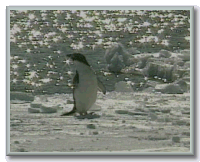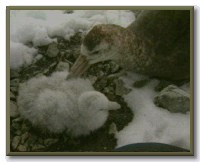Food in the form of marine zooplankton, cephalopods and fish is readily available to them. Little, if any, food is available on the Antarctic continent to support terrestrial species, even if they were physiologically equipped to withstand the rigors of an Antarctic winter. Thus, most of these birds depend entirely on the sea for food and spend most of their life at sea in search of it. Some, notably the albatrosses and petrels, spend the first few years without ever visiting land, while others visit occasionally.
Because of the very large numbers of sea birds and the amount of food they eat, they are important components of the marine ecosystem, like seals and whales.
|
|
|
Antarctic species can be divided into four major groups or orders. Of these the Petrels (order Procellariformes) comprise the greatest number of species and include the albatrosses, petrels, shearwaters, prions, storm petrels and the diving petrels. Petrels are a diverse group of birds linked by the common characteristics of tube-like nostrils on the upper beak. They range in size from the Wandering Albatross, which has a wing span of about 3m, down to the tiny Wilson's Storm Petrel, which weighs 35g and has a wing span of 40cm.
All are marine species adapted for a life at sea. On land most have difficulty in walking and generally visit it only in the breeding season. All species feed at sea. The smaller birds feed on zooplankton including krill, and the larger species (albatrosses and some petrels) consume large squid, fish and crustaceans. The Giant Petrels also feed ashore on carrion, and these and many other species (Albatrosses, Cape Petrels, Storm Petrels) feed at sea on the organic wastes discharged by ships.
|
|
WANT TO LEARN MORE?
|
|
|
Websites
• Antarctic petrel Information including taxonomy of the Antarctic petrel. • South polar skua Information on the South polar skua includes taxonomy information. • Southern giant-petrel Facts about the Southern giant-petrel including taxonomy. • Prehistory More background information on the prehistory of Antarctica. • Antarctic Adventure 1997 Information on the geography and climate of Antarctica. |
|
![]()

